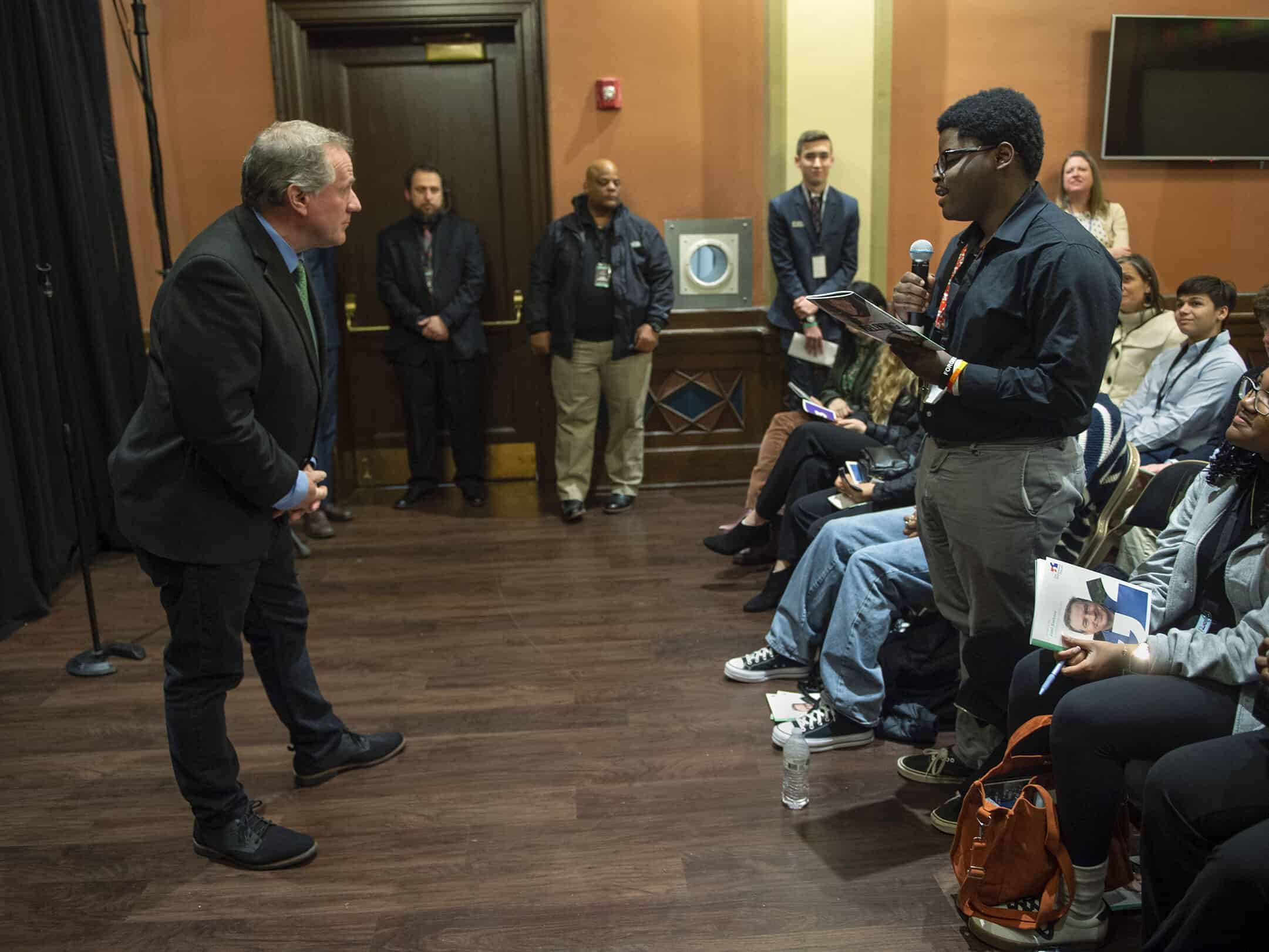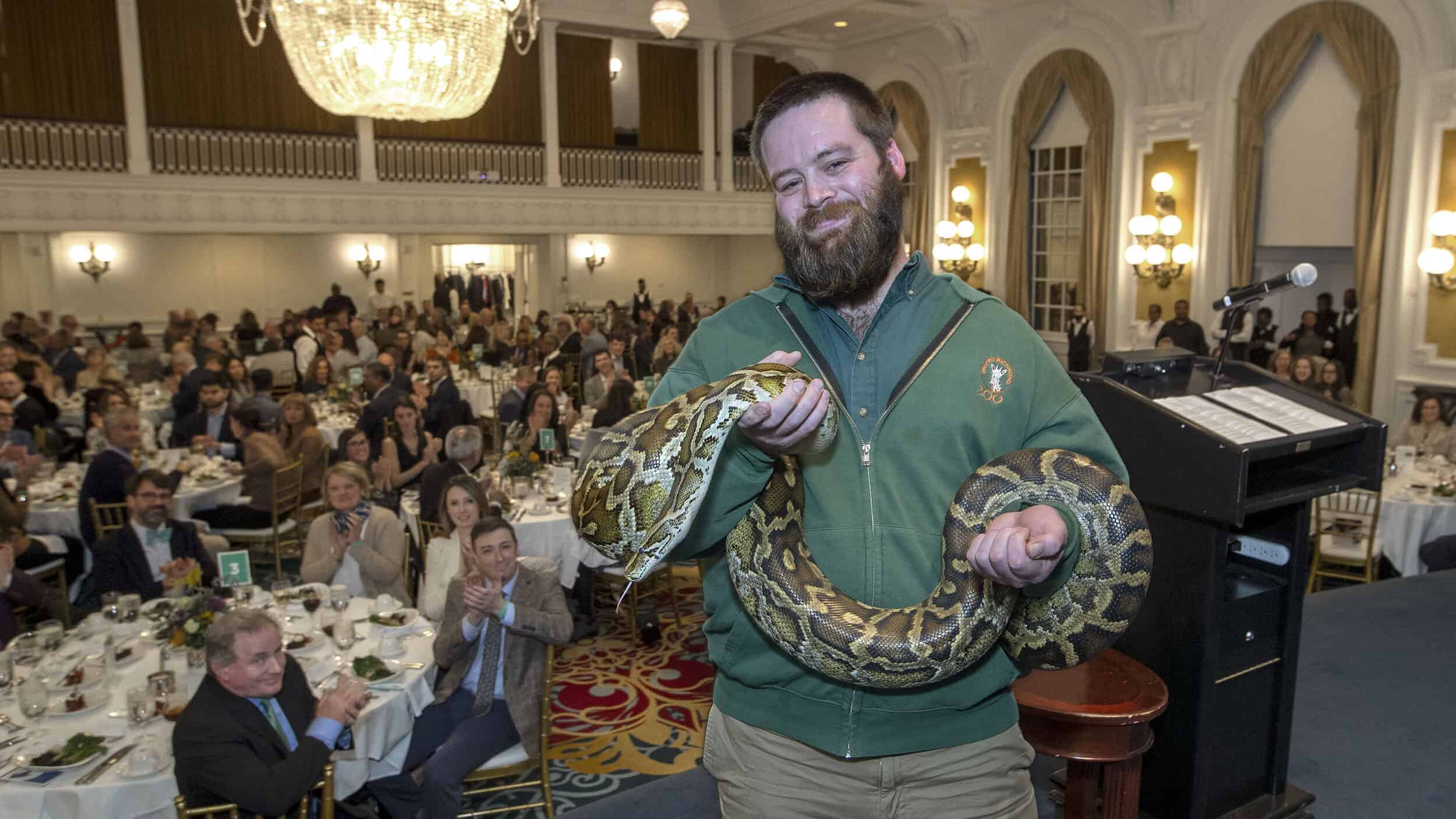Past Event On January 13, 2024
Joel Sartore
Boarding the Photo Ark
We went behind the lens of the National Geographic photographer’s project, The Photo Ark, which has documented more than 15,000 animal species and aims to save animals from extinction.


“The key to our own salvation lies in this brown slimy frog the size of a tennis ball. For if I can get people to care about [the now-extinct Rabbs’ fringe-limbed treefrog], aren’t you going to care about everything else?”
Joel Sartore
Boarding the Photo Ark
Program Date: January 13, 2024
For 17 years, Joel Sartore has traveled the world to photograph thousands of species for The Photo Ark, his ambitious initiative to document every animal in human care. In the process, Sartore has been mobbed by a gang of mischievous spider monkeys, nearly lost a finger to a camera-shy hornbill, and even contracted a flesh-eating parasite in pursuit of the perfect shot — all on a mission to make the world care that Earth’s biodiversity is in grave peril.
Sartore added Virginia to his list of global destinations on January 13, 2024, to address The Richmond Forum. His engagement, “Boarding the Photo Ark,” captivated the Forum audience with stunning images and humorous anecdotes that brought color and context to his stories from behind the lens.
“I tell these stories to try to get people to care,” Sartore said. Since the beginning of his endeavor in 2006, Sartore’s stories and photographs have proven to do just that. Many vulnerable species have been saved from extinction as a result.
“We have a lot to celebrate: the Mexican grey wolf, the California condor, the whooping crane, the black-footed ferret, and the Vancouver Island marmot. These animals were all down to fewer than two dozen,” he said. “They’re not completely out of the woods, but they are certainly safe for now.”
In 2023, the 15,000th species boarded The Photo Ark. The federally endangered Miami tiger beetle dwells primarily in the Pine Rocklands ecosystem of southern Florida, a portion of which was slated to be demolished to make way for a new water park. The publicity around the Ark’s milestone drew attention to the beetle and its impending demise. Sartore revealed that a few weeks ago, the development plans were scrapped in response to community pressure.
“We’ll stand guard over works of art 24 hours a day with armed guards and security systems that cost millions, and yet we’ll throw any of nature’s works of art away?”
– Joel Sartore



Although Sartore has successfully advocated for the protection of many species, not every story he told had a happy ending. He shared photos of several animals that have been declared extinct in the time since he captured their likeness, including Toughie, the last remaining Rabbs’ fringe-limbed treefrog, who died in 2016. According to Sartore, between 30 and 40% of amphibians could vanish within the next few years if swift action isn’t taken.
The northern white rhinoceros is also close to extinction. Only two remain on the planet – a mother and daughter pair living at the Ol Pejeta Conservancy in Kenya. “What will we do when those go extinct?” Sartore asked. “We’ll write some editorials and we’ll be sad a little bit, but then the Kardashians will do something crazy and that’ll wash that away.”
Even in the face of loss, Sartore is “as hopeful as can be that we can turn this around and get people to start caring.” Most of these species can be saved as long as action is taken quickly, he said. He offered the following suggestions for anyone who wants to protect Earth’s creatures, both big and small:
- Go native. Introduce native plants to your garden to attract bees and butterflies and filter groundwater. If you don’t have a yard, a pot with native plants on a window ledge or balcony can still make an impact.
- Leave your leaves. Rather than rake up fallen leaves and pine needles, mulch them and leave them to nourish the insects and soil in your yard.
- Keep your cat inside. Outdoor cats kill more birds every year than wind turbines. Even the gentlest of feline friends can quickly turn into a skilled hunter when out in the wild.
- Go to the zoo. Action starts with education. “Good zoos are the thumb in the dike keeping nature from collapsing. We have to educate. We have to show people what these animals look like and sound like and smell like.”
- Take to social media. Share content from The Photo Ark, and other photographers like Sartore, to showcase the faces of vulnerable species. The more people know what is at stake, the more pressure gets put on entities that can make a big difference in protecting vulnerable species.
To Sartore, a big difference can also come from a large number of people making these small efforts. Sartore brought the evening to a close by sending the Forum audience back into the world with a call to join him on his mission.
“All you’ve got is that dash between the numbers on your tombstone. Don’t you want to do something that makes the world a better place? I know I do. If we had a room this big with this many people who all of a sudden were on fire to save the planet, could we make a dent? You bet we could! Let’s get to work.”



“Joel is such an awesome storyteller. I could listen to his stories and look at his pictures for hours. His personal details gave an insight into his life that added to the story. I will take his challenge. I am planning landscaping project for spring and now plan to investigate adding plants native to this area.”
– Subscriber Survey Comment

About Joel Sartore
Joel Sartore is an award-winning photographer, conservationist, author, speaker, and the 2018 National Geographic Explorer of the Year. He is also a proud Eagle Scout. Sartore specializes in documenting endangered species and landscapes around the world.
He is the founder of the Photo Ark, a 25-year documentary project that aims to help save animal species and habitats by supporting conservation efforts and inspiring action through education. Sartore and the Photo Ark are the subjects of the PBS special “RARE,” which follows his journey to photograph some of the most endangered creatures left on Earth.
He is a regular contributor to National Geographic, Audubon, GEO, The New York Times, and Smithsonian. Sartore has published several books, including “Photo Ark: A World Worth Saving,” “The Photo Ark Vanishing: The World’s Most Vulnerable Animals,” “Birds of the Photo Ark,” and “RARE: Portraits of America’s Endangered Species.” In 2021, Sartore was inducted into the International Photography Hall of Fame and Museum and received the Ansel Adams Award for Conservation Photography from the Sierra Club.
Sartore and his work have been the subject of many national broadcasts, including National Geographic’s “Explorer,” “NBC Nightly News,” “CBS Sunday Morning,” “Nightline,” NPR’s “Weekend Edition,” “PBS NewsHour,” “Fresh Air,” “60 Minutes,” and “TODAY.” This year, the U.S. Postal Service released 20 stamps featuring Photo Ark images of endangered animal species living in the United States.
Known for his Midwestern work ethic, Sartore is always happy to return from his world travels to his home in Lincoln, Nebraska.
Additional Resources
WATCH PROGRAM HIGHLIGHTS

